|
West Didsbury Metrolink Station
West Didsbury is a tram stop on the South Manchester Line (SML) of Greater Manchester's light-rail Metrolink system. It opened to passengers on 23 May 2013, in West Didsbury, South Manchester, England. The Metrolink stop sits some 300m south east of the former heavy rail station of the Midland Railway, which opened 1 January 1880 as Withington; was renamed on 1 July 1884 to Withington and Albert Park; renamed again on 1 April 1915 to Withington and West Didsbury; and closed 3 July 1961. The route was earmarked for redevelopment with a light rail system during the 1980s, and was confirmed and funded as part of Metrolink's Phase 3b of expansion in 2006. Service pattern *12 minute service to , with double trams at peak times; *12 minute service to , with double trams at peak times; *6 minute service to , with double trams at peak times. History Railway station Withington and West Didsbury railway station opened in 1880 as "Withington" when the Midland Railway opened its new ... [...More Info...] [...Related Items...] OR: [Wikipedia] [Google] [Baidu] |
Manchester Metrolink
Manchester Metrolink (branded locally simply as Metrolink) is a tram/ light rail system in Greater Manchester, England. The network has 99 stops along of standard-gauge route, making it the most extensive light rail system in the United Kingdom. Metrolink is owned by the public body Transport for Greater Manchester (TfGM) and operated and maintained under contract by a Keolis/ Amey consortium. In 2021/22, 26 million passenger journeys were made on the system. The network consists of eight lines which radiate from Manchester city centre to termini at Altrincham, Ashton-under-Lyne, Bury, East Didsbury, Eccles, Manchester Airport, Rochdale and Trafford Centre. It runs on a mixture of on-street track shared with other traffic; reserved track sections segregated from other traffic, and converted former railway lines. Metrolink is operated by a fleet of 147 high-floor Bombardier M5000 light rail vehicles. Each service runs to a 12-minute headway; stops with more than one serv ... [...More Info...] [...Related Items...] OR: [Wikipedia] [Google] [Baidu] |
Withington And West Didsbury Railway Station
Withington and West Didsbury railway station (previously named Withington railway station and Withington & Albert Park railway station) is a former station in West Didsbury, in the southern suburbs of Manchester, England, United Kingdom. The station was located on Lapwing Lane, close to the junction with Palatine Road and opposite Withington Town Hall. Nothing now remains of the old station buildings, which have been demolished. West Didsbury is now served by West Didsbury tram stop which is approximately further down the line from the original railway station. History In 1873, the Manchester South District Railway obtained permission to construct a new railway line from Manchester to Alderley. The company fell into financial difficulty and was eventually bought out by the Midland Railway in 1877, who went on to build the line. Construction began in 1878 and the line opened to passenger service on 1 January 1880, running from the new Manchester Central Station through south ... [...More Info...] [...Related Items...] OR: [Wikipedia] [Google] [Baidu] |
Railway Stations In Great Britain Opened In 1880
Rail transport (also known as train transport) is a means of transport that transfers passengers and goods on wheeled vehicles running on rails, which are incorporated in tracks. In contrast to road transport, where the vehicles run on a prepared flat surface, rail vehicles (rolling stock) are directionally guided by the tracks on which they run. Tracks usually consist of steel rails, installed on sleepers (ties) set in ballast, on which the rolling stock, usually fitted with metal wheels, moves. Other variations are also possible, such as "slab track", in which the rails are fastened to a concrete foundation resting on a prepared subsurface. Rolling stock in a rail transport system generally encounters lower frictional resistance than rubber-tyred road vehicles, so passenger and freight cars (carriages and wagons) can be coupled into longer trains. The operation is carried out by a railway company, providing transport between train stations or freight customer facili ... [...More Info...] [...Related Items...] OR: [Wikipedia] [Google] [Baidu] |
Former Midland Railway Stations
A former is an object, such as a template, gauge or cutting die, which is used to form something such as a boat's hull. Typically, a former gives shape to a structure that may have complex curvature. A former may become an integral part of the finished structure, as in an aircraft fuselage, or it may be removable, being using in the construction process and then discarded or re-used. Aircraft formers Formers are used in the construction of aircraft fuselage, of which a typical fuselage has a series from the nose to the empennage, typically perpendicular to the longitudinal axis of the aircraft. The primary purpose of formers is to establish the shape of the fuselage and reduce the column length of stringers to prevent instability. Formers are typically attached to longerons, which support the skin of the aircraft. The "former-and-longeron" technique (also called stations and stringers) was adopted from boat construction, and was typical of light aircraft built until the ad ... [...More Info...] [...Related Items...] OR: [Wikipedia] [Google] [Baidu] |
Tram Stops In Manchester
A tram (called a streetcar or trolley in North America) is a rail vehicle that travels on tramway tracks on public urban streets; some include segments on segregated right-of-way. The tramlines or networks operated as public transport are called tramways or simply trams/streetcars. Many recently built tramways use the contemporary term light rail. The vehicles are called streetcars or trolleys (not to be confused with trolleybus) in North America and trams or tramcars elsewhere. The first two terms are often used interchangeably in the United States, with ''trolley'' being the preferred term in the eastern US and ''streetcar'' in the western US. ''Streetcar'' or ''tramway'' are preferred in Canada. In parts of the United States, internally powered buses made to resemble a streetcar are often referred to as "trolleys". To avoid further confusion with trolley buses, the American Public Transportation Association (APTA) refers to them as "trolley-replica buses". In the United ... [...More Info...] [...Related Items...] OR: [Wikipedia] [Google] [Baidu] |
Withington
Withington is a suburb of Manchester, England. Historically part of Lancashire, it lies from Manchester city centre, about south of Fallowfield, north-east of Didsbury and east of Chorlton-cum-Hardy. Withington has a population of just over 14,000 people, reducing at the 2011 census to 13,422. In the early 13th century, Withington occupied a feudal estate that included the townships of Withington, Chorlton-cum-Hardy, Moss Side, Rusholme, Burnage, Denton and Haughton, held by the Hathersage, Longford and Tatton families, and within the Manor of Manchester and Hundred of Salford in historic county boundaries of Lancashire. Withington was largely rural until the mid-19th century when it experienced rapid socioeconomic development and urbanisation due to the Industrial Revolution, and Manchester's growing level of industrialisation. Withington became part of Manchester in 1904. Today, the residents of Withington comprise a mixture of families, university students a ... [...More Info...] [...Related Items...] OR: [Wikipedia] [Google] [Baidu] |
Didsbury Railway Station
Didsbury railway station is a former station in Didsbury, in the southern suburbs of Manchester, England, United Kingdom. The station was located on Wilmslow Road, just north of the junction with Barlow Moor Road and opposite Didsbury Library. Nothing now remains of the old station buildings, which have been demolished, but the surviving white Portland stone clock tower is a local landmark. Didsbury is now served by Didsbury Village tram stop which is close to the site of the former railway station. History In 1873, the Manchester South District Railway obtained permission to construct a new railway line from Manchester to Alderley. The company fell into financial difficulty and was eventually bought out by the Midland Railway in 1877, who went on to build the line. Construction began in 1878 and the line — including Didsbury Station — opened to passenger service on 1 January 1880, running from the new Manchester Central Station through south Manchester suburbs to . The ... [...More Info...] [...Related Items...] OR: [Wikipedia] [Google] [Baidu] |
Sheffield And Midland Railway Companies' Committee
The Sheffield and Midland Railway Companies' Committee was incorporated by Act of Parliament in 1869 as a joint venture between the Midland Railway and the Manchester, Sheffield and Lincolnshire Railway. Origins For many years the Midland had been wishing to extend its line from London St.Pancras to Manchester, via Derby and the Manchester, Buxton, Matlock and Midlands Junction Railway. It was thwarted by the London and North Western Railway which already had a line from Manchester to London, via Birmingham and had built a branch line to Buxton. Meanwhile, The Great Northern Railway was also averse to more competition in the area, and the MS&LR wished to expand southwards from its main line from Manchester, via Penistone, to Sheffield. The three joined forces in a series of tripartite agreements, which not being sanctioned by Parliament, were of doubtful legality. However James Allport, with some other Midland directors, met some members of the MS&L board while surveying the ... [...More Info...] [...Related Items...] OR: [Wikipedia] [Google] [Baidu] |
Trackbed
The track bed or trackbed is the groundwork onto which a railway track is laid. Trackbeds of disused railways are sometimes used for recreational paths or new light rail links. According to Network Rail, the trackbed is the layers of ballast and sub-ballast above a prepared subgrade/formation (see diagram). It is designed primarily to reduce the stress on the subgrade. Other definitions include the surface of the ballast on which the track is laid,, p. 386. the area left after a track has been dismantled and the ballast removed or the track formation beneath the ballast and above the natural ground. The trackbed can significantly influence the performance of the track, especially ride quality of passenger services. See also * Embankment (transportation) * Roadbed * Subgrade In transport engineering, subgrade is the native material underneath a constructed road,http://www.highwaysmaintenance.com/drainage.htm The Idiots' Guide to Highways Maintenance ''highwaysmaintenence. ... [...More Info...] [...Related Items...] OR: [Wikipedia] [Google] [Baidu] |
Tram
A tram (called a streetcar or trolley in North America) is a rail vehicle that travels on tramway tracks on public urban streets; some include segments on segregated right-of-way. The tramlines or networks operated as public transport are called tramways or simply trams/streetcars. Many recently built tramways use the contemporary term light rail. The vehicles are called streetcars or trolleys (not to be confused with trolleybus) in North America and trams or tramcars elsewhere. The first two terms are often used interchangeably in the United States, with ''trolley'' being the preferred term in the eastern US and ''streetcar'' in the western US. ''Streetcar'' or ''tramway'' are preferred in Canada. In parts of the United States, internally powered buses made to resemble a streetcar are often referred to as "trolleys". To avoid further confusion with trolley buses, the American Public Transportation Association (APTA) refers to them as "trolley-replica buses". In the Unit ... [...More Info...] [...Related Items...] OR: [Wikipedia] [Google] [Baidu] |
GMPTE
Greater Manchester Passenger Transport Executive was the public body responsible for public transport in Greater Manchester between 1974 and 2011, when it became part of Transport for Greater Manchester. SELNEC PTE Until 1969, the conurbation surrounding Manchester was divided between the two administrative counties of Lancashire and Cheshire and a number of county boroughs, such as Manchester, Salford, Stockport or Bolton. To comply with the Transport Act 1968, on 1 April 1969 the SELNEC Passenger Transport Executive was formed. ''SELNEC'' stood for ''South East Lancashire North East Cheshire'', a joint authority of the various local councils. From 1 November 1969, the PTE took over the bus fleets of 11 municipalities, and operationally, the organisation was split into three divisional areas, Northern, Central, and Southern: Northern *Bolton Corporation (249 vehicles) * Bury Corporation (96 vehicles) * Leigh Corporation (57 vehicles) *Ramsbottom Urban District Council ... [...More Info...] [...Related Items...] OR: [Wikipedia] [Google] [Baidu] |
Greater Manchester Council
The Greater Manchester County Council (GMCC) was the top-tier local government administrative body for Greater Manchester from 1974 to 1986. A strategic authority, with responsibilities for roads, public transport, planning, emergency services and waste disposal, it was composed of 106 directly elected members drawn from the ten metropolitan boroughs of Greater Manchester. The Greater Manchester County Council shared power with ten lower-tier district councils, each of which directed local matters. It was also known as the Greater Manchester Council (GMC) and the Greater Manchester Metropolitan County Council (GMMCC). Established with reference to the Local Government Act 1972, elections in 1973 brought about the county council's launch as a shadow authority, several months before Greater Manchester (its zone of influence) was officially created on 1 April 1974. The Greater Manchester County Council operated from its County Hall headquarters on Portland Street in central Manch ... [...More Info...] [...Related Items...] OR: [Wikipedia] [Google] [Baidu] |









.png)